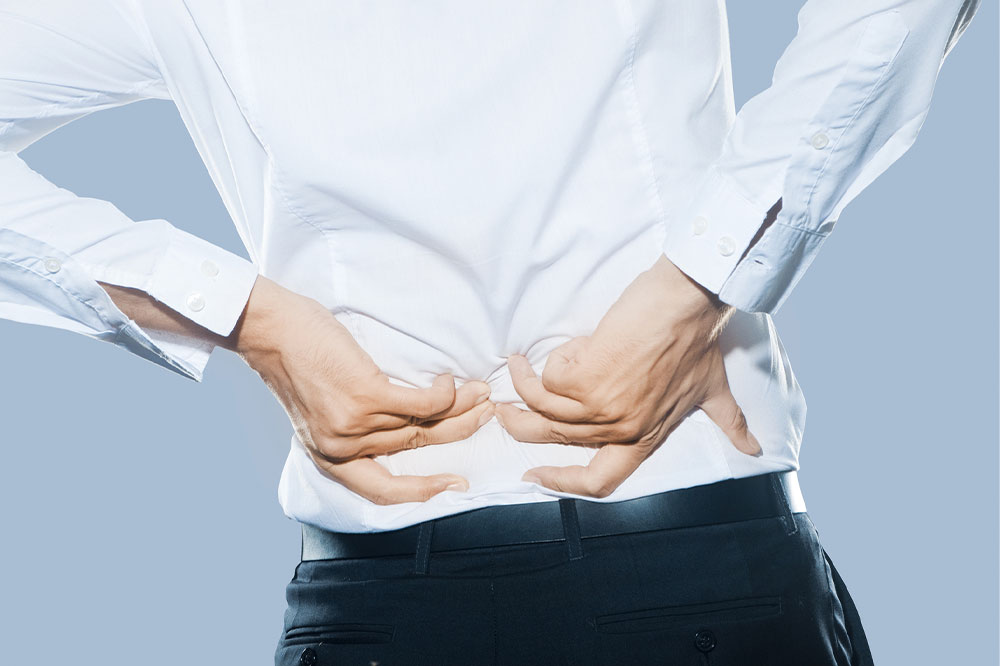
Back pain – causes, risk factors, symptoms, diagnoses, and treatment
The human back is made of complex muscle structures, tendons, discs, bones, and ligaments. The spine’s segments are cushioned with cartilage-like pads called discs. Together, these factors support the body and enable an individual to move freely. However, damage or problems to any of these components can lead to back pain and other symptoms linked to the chronic condition. Such pain can impact a person’s lifestyle and affect their ability to focus on work.
Cause of back pain
The damage to the components in the back can result from a number of factors.
Strain
Strain is a common factor that can lead to back pain. Physical activities that may lead to strain or spasms include lifting an object incorrectly. Strain may also result from lifting an extremely heavy object or because of a sudden movement. Tension and injuries are other factors that can contribute to such pain. A few recurring causes of back pain include:
- Tension build-up in the muscles
- A muscle spasm
- Strained ligaments
- Strained muscles
- Damage to the discs in the spine
- Physical injuries and fractures
Unhealthy lifestyle
The way a person spends their day at home or work can drastically affect their overall health and lead to back pain. A few situations that can result in such pain are:
- A hunched position at a computer desk may lead to an increase in shoulder and back problems.
- Standing, sitting, or bending in an uncomfortable position for a prolonged time
- Coughing and sneezing
- Twisting and excessive stretching of the back
- A mattress that does not keep the spine straight
- Straining the neck forward while driving
- Driving for long durations without a break
Medical conditions
Back pain can also result from a number of underlying medical conditions such as:
- Spinal tumor: A spinal tumor is an abnormal growth that stems from the tissues that make up the spine. When these tumors press against a nerve, it may cause back pain.
- Sleep disorders: People affected by sleep disorders are at a greater risk of back pain.
- Cauda equina syndrome: The cauda equina is a bundle of spinal nerve roots that stem from the lower end of the spinal cord. The condition leads to chronic pain in the lower back and other regions of the body.
- Infections: Infections like a fever of the spine, bladder, or kidney infections, even pelvic inflammatory disease, may lead to back pain.
The risk factors
Multiple factors put an individual at risk of developing back pain.
- Psychological conditions: Research suggests that people who face depression and anxiety are at a higher risk of developing back pain.
- Limited exercise: Limited exercise leaves muscles weak and unused in the back and abdomen.
- Overweight: Too much body weight puts extra pressure and stress on the back.
- Age: Back pain can affect people of all ages but is more common in people who are 30 years or older.
- Diseases: Arthritis and cancer are underlying health problems that may cause back pain.
Symptoms of back pain
Though the primary symptom of back pain is an ache or pain in the back, it may also lead to other symptoms such as:
- Fever
- Loss of weight
- Urinary incontinence
- Fecal incontinence
- Pain in the legs or below the knees
- Inflammation on the back
- Numbness around the anus
Types of diagnoses
Back pain is diagnosed after monitoring its symptoms and following a physical examination. However, the condition may require an imaging scan or other tests to assess chronic pains. These tests include X-rays, MRI or CT scans, bone scans, and electromyography. Further, back pain can be diagnosed via a chiropractor, an osteopath, or a physical therapist.
Treatment
There are various treatments for back pain that include:
- Home treatments: Over-the-counter pain relief medications like ibuprofen help relieve discomfort. Applying a hot compress, using an ice pack, or resting at home are other methods to relieve back pain.
- Prescription analgesics: People who do not respond well to OTC painkillers may require NSAIDs like codeine or hydrocodone – prescription analgesics for pain relief.
- Physical therapy: The application of heat, ice, ultrasound, and electrical stimulation also help reduce back pain.
When should you visit the doctor?
A visit to the doctor is recommended if back pain does not improve with time or if the person experiences weakness, develops a fever, or experiences numbness in the legs. Further, those who experience back pain after an injury or fall should also see a doctor.




